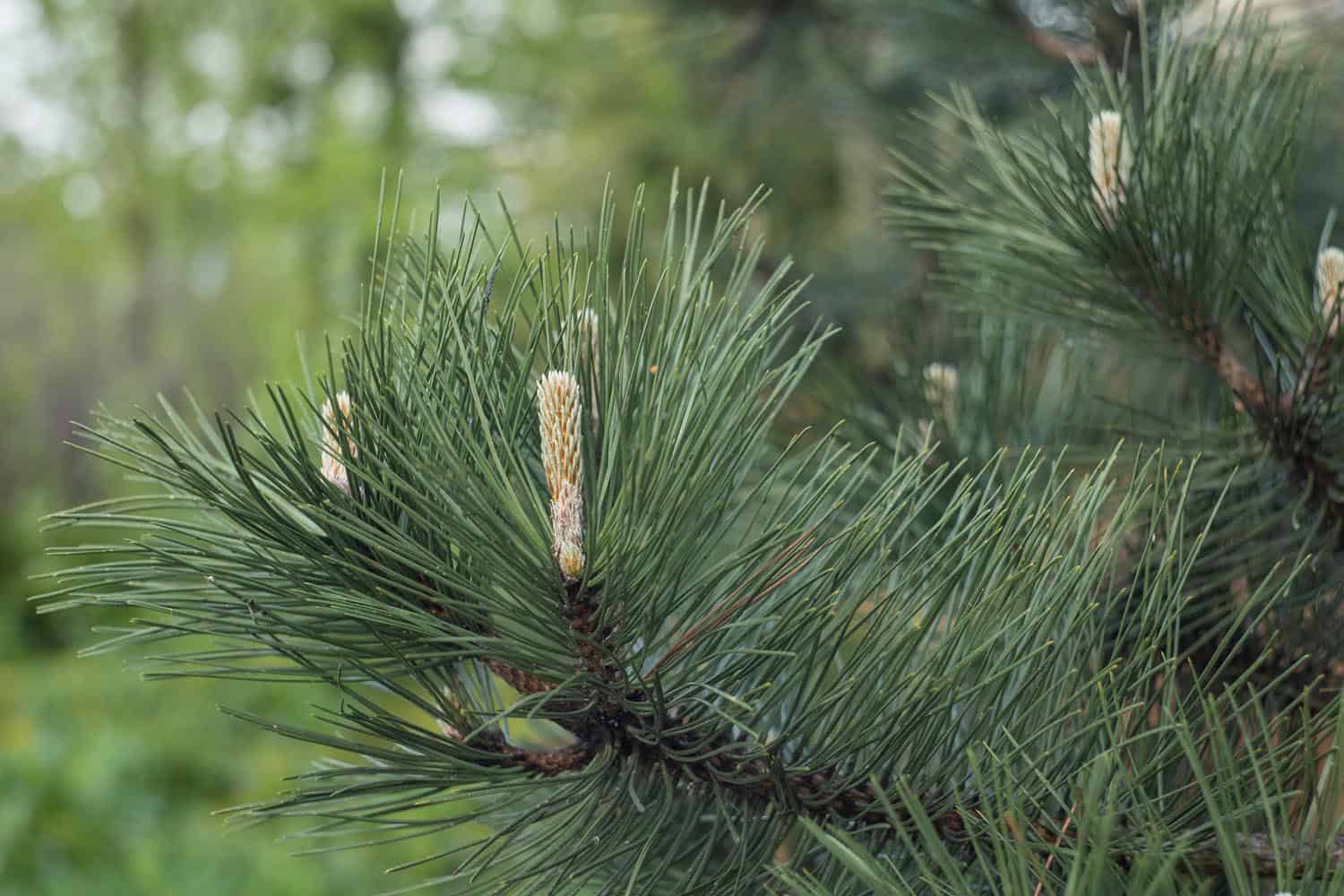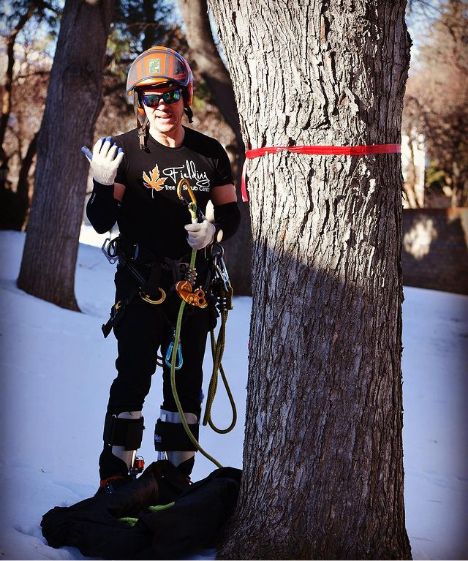Colorado residents seek dense, bright, green pine trees for several purposes. These trees’ vibrant color and ability to thrive in adverse conditions make them a top choice for home gardens and public spaces. Being such a popular tree in our state, pine tree maintenance is a must for happy Colorado homeowners.
Pine Tree Species Commonly Found in Denver
Part of the Pinaceae Pinus tree family, there are believed to be 126 species of pine trees in total. Denver is home to a handful of these hardy and attractive conifer trees. Each pine species is distinct, even though they share some fundamental similarities. Before learning what pine tree maintenance entails, let’s first go ever each species and see if you can identify them the next time you’re out on a hike!
Austrian Pine
The Austrian Pine is a hardy, low-maintenance tree common to the Denver metro area. A moderate to fast-growing tree, the Austrian pine will add beauty and character to any Colorado landscape. Their rich, green-colored needles measure 4 to 6 inches long, and remain vivid throughout the winter. Its height can reach up to 60 feet and spread up to 40 feet. The Austrian Pine is well-known to be drought- tolerant and can have a very long lifespan.
Ponderosa Pine
Adding 12 inches of height or more each year, the Ponderosa Pine quickly grows to stand between 60 and 125 feet tall at maturity. This species features an orange-brown bark that grows in patterned rough rectangular plates. The tree has an overall narrow conical shape and attractive rugged appearance. Of all the pine varieties, it is most resistant to salt-spray and has few issues with disease or pests. Although it is low maintenance, this pine needs room to grow and should not be planted in a crowded garden area. Its trunk alone can span 4 feet when fully mature! For best results, plant in full sun and well-drained soil.
FUN FACT: If you press your nose up against the bark of this tree, some people can smell notes of butterscotch, vanilla, and/or caramel. It’s a key Forestry ID tool.
Scotch Pine
Standing 30 to 100 feet tall, and spreading almost half as wide at maturity, the Scotch Pine has a unique conical shape. An illustration of this is their branches that spread horizontally with age, giving it a flattering full shape, and making it an ideal Christmas tree. The average lifespan of a Scotch Pine is typically 150 to 300 years! This variety tolerates many soil types and climates, prefers full sun, and can be transplanted with ease. It’s an ideal choice for tough sites and makes an excellent shade or screen tree.
Pinyon Pine
Native to the southwestern United States, the Pinyon Pine is a slow-growing but long-living variety. Dense and compact, this soft bushy tree grows only to 10 or 20 feet, so it won’t crowd out other plants or shrubs. Its cones produce edible nuts that are tasty raw or toasted! Drought resistant and tolerant of many soils, Pinyon Pines work well in rock gardens and xeriscaping.
Mugo Pine
Mugo pine is a versatile, ornamental pine that can be planted in a variety of settings. Its hardy nature makes it a popular choice for use in Colorado residential landscaping. Its low-growing profile and 2 to 4 foot spread make it a wonderful addition to gardens and along walkways. The Mugo Pine is relatively low maintenance, and will tolerate a wide range of conditions, making it a solid planting selection.
Vanderwolf White Pine
The attractive, and fast-growing Vanderwolf Pine will nicely enhance your landscape’s appearance. It grows up to 40 feet tall and serves as a pleasing alternative to other large pine and spruce trees. Its smooth, long, bluish needles and pyramidal shape make it a lovely evergreen tree. Once established, the Vanderwolf Pine is a strong choice to withstand drought conditions and other threats like pests and disease.
Limber Pine
Found in zones 4-7, this fast-growing pine species is highly drought-resistant and tolerant of many soils. Limber Pines prefer well-drained soil and can thrive in rocky soil, making them a strong choice for natural plantings. Additionally, its dense blue-green needles form an attractive pyramid shape. This hardy species is often sought after for its ability to resist disease and pests. At maturity, it only grows to 20 or 30 feet, making it a great option for a garden or screening.
Bristlecone Pine
Bristlecone Pines are famous for being the oldest living tree species. Adaptable to many climates, they grow well in zones 3-7 and even thrive in acidic soil. They prefer full sun, and, under ideal conditions, grow 20 to 60 feet tall and spread 15 to 20 feet wide. Thanks to their dense wood, Bristlecone Pines can fend off attacks from harmful pests and fungi. This variety is also hardy during drought conditions and makes a great patio or garden accent tree.
Lodgepole Pine
The Lodgepole Pine requires very specific growing conditions, not found below 8,000 feet, so they are quite rare in the Denver metro area. When it’s young, the Lodgepole Pine makes an excellent ornamental tree. Its yellow-green needles and flaky orange bark are unique and quite attractive. As it ages, it grows in a rounded shape, reaching 70 to 80 feet tall and 20 feet wide at maturity. The Lodgepole pine can thrive in acidic, loamy, moist, and even clay soils. It prefers full to partial sun and grows at a medium rate.
How to Identify Pine Trees
Wondering what the difference between a fir and a pine tree is? You can do a quick check in the yard following these easy steps. Pine tree identification typically depends on three things: the cones, the bark, and the way the needles are clustered.
Needles
Pine tree leaves are called needles because they’re long and thin in shape. As a matter of fact, if you look closely, you’ll see they grow in a spiral out of the twigs stemming from larger branches! These spirals are called “candles” and they fall from the tree after about two or three years. If you feel the needles, you will see that they have a waxy, protective outer-layer. This layer helps the pine withstand drought and prevents it from catching fire.
Bark
Pine bark is usually rough to the touch and thick, which helps it defend itself from pests. It’s typically grey, with black edges and occasionally streaks of reddish-brown depending on the cultivar, or species edges.
Cones
Pine trees produce both male and female cones. The female cone is chubby, with thick woody petals growing from the center outwards. Male pinecones are formed in a tighter cylinder shape and hold pollen that will fertilize the female pinecone.
Pine Tree Diseases and Infestation
Pine trees in the Denver area are primarily plagued by IPS Beetle infestation and Pine Wilt disease. Find out more about the causes, how to spot the first signs of problems, and provide the best pine tree maintenance possible. You can find more details in the Pine Wilt and IPS Beetle guides from the Colorado State University Extension.
IPS Beetle Infestation
Quick Facts:
- The IPS Beetle is also called the “engraver beetle,” with 11 known species in Colorado.
- The IPS beetle measures ⅜ inches long, and has a dark, reddish-brown or black color.
- IPS Beetles attack pine and spruce trees and feed on the phloem of the wood.
- When trees are stressed or unhealthy, IPS Beetle infestation is a common problem.
- IPS Beetles can tolerate the cold weather and produce multiple generations per year.
Hosts:
- IPS Beetles attack with discretion and commonly target Blue Spruce, Englemann Spruce, Concolor/Noble Fir, Subalpine Fir, Ponderosa and Pinyon pines.
- Due to the rapid growth of this pest in the Denver Metro area, the IPS beetle is striking popular Austrian and Scotch pines as well.
Symptoms:
- Rapid fading on the top or whole tree will appear between spring or early fall.
- Signs of woodpecker damage including feeding marks on the outside of the tree and large branches.
- During warmer months you may notice traces of boring dust at the base of the tree or cracks of the bark.
- A quick inspection of the underside of the bark may reveal boring paths made by IPS beetles shaped in a “Y” or “H” design.
- Small, round-shaped exit holes in the trunk of the tree indicate the IPS Beetle has moved on to another part of the tree or a different tree altogether.
Pine Wilt disease
Quick Facts:
- Pine Wilt is a lethal disease caused by a native nematode, vectored to trees by a wood borer insect: the Pine Sawyer Beetle.
- Exotic pines, including Scots, Austrian, and Mugo, are susceptible to infection by the nematode. Native pines are not susceptible to this pathogen.
- High summer temperatures are required for the nematode to develop in the beetle and within infested trees.
- The disease is now a threat in both eastern and western Colorado. It can be prevented by timely sanitation and chemical injections.
Hosts:
- Native ponderosa, limber, bristlecone, and lodgepole pines are normally not susceptible to the disease. They have built up a resistance to the nematode, but that resistance can be compromised by periods of drought.
- Pine wilt is a lethal disease of the widely planted Scots, Austrian and mugo pines.
Symptoms:
- Infection usually starts in June or July, but visible symptoms won’t appear until early fall.
- When nematodes attack susceptible trees, they feed on the epithelial cells of resin ducts and move systemically throughout the sapwood of the branches, trunk, and roots. This causes physical changes within the tree resulting in water blockage, wilting and death.
- Needles to initially turn grayish turn from gray-green to tan and eventually brown due to lack of water.
- Dead needles remain attached to the tree through the winter.
- Diseased wood is very dry to the touch as the infection process interferes with resin production.
- Infected trees also develop a blue stain in the wood.
- On Scots Pines, the entire tree usually wilts and dies within a few months.
Mountain Pine Beetle
Quick Facts:
- Mountain pine beetles (MPB) are the most significant pest of Colorado’s pine forests. MPB often kill large numbers of trees annually during outbreaks.
- Trees that are not growing vigorously due to old age, crowding, poor growing conditions, drought, fire or mechanical damage, root disease and other causes are most likely to be attacked.
- For a long-term remedy, thin susceptible standing trees. Leave well-spaced, healthy trees.
- For short-term controls, spray, cover, burn, or peel attacked trees to kill the beetles. Preventive sprays can protect green healthy trees.
Hosts:
- Mountain pine beetles develop in pines, particularly Ponderosa, Lodgepole, Scotch and Limber Pines.
- Bristlecone and Pinyon Pine are less commonly attacked.
- During the early stages of an outbreak, attacks are limited mainly to trees under stress from injury, poor site conditions, or root disease.
Symptoms:
- Popcorn-shaped masses of resin, called “pitch tubes,” on the trunk where beetle tunneling begins. Pitch tubes may be brown, pink, or white.
- Boring dust in bark crevices and on the ground.
- Evidence of woodpecker feeding on the trunk.
- Needles turning yellowish to reddish throughout the entire tree crown.
- Presence of live MPB as well as galleries under the bark. This is the most certain indicator of an infestation. A hatchet for removal of bark is needed to check trees correctly.
- Blue-stained sapwood in the tree trunk.
Important Tree Information for Proper Pine Tree Maintenance
Austrian Pine trees, Ponderosa Pine trees, it doesn’t matter what type – pine trees are falling over across Denver and other areas in Colorado. What causes pine trees to fall over? You may be surprised. There are two reasons why pine trees are susceptible to falling over.
Pine trees + damaged roots + high winds = death sentence for pines.
They grow best in a forest setting, not as standalone trees. If you disturb the soil around a pine’s root base, it can easily damage the root system and start the deterioration process. A damaged root system is often a death sentence for a pine tree. Even compacting the soil around a pine tree can sometimes be enough to damage its roots.
Pine trees + shallow soil = no depth for stability.
Pine trees also need deep soil to sink their roots into for stability. Their root system can extend away from the tree at a distance as much as twice the height of the tree. These trees, notably Ponderosa Pines, tend to have a deep tap root with a much shallower root system. The shallower roots follow cracks and water spots for the pine to quench its thirst. If the tap root does have at least two feet of penetrable ground, its strength is only found in the shallow roots extending away from the tree base. Shallow roots and no firm tap root depth is a recipe for toppling under high winds. Your pine tree may already be in a less than ideal location.
We recommend having a certified arborist inspect your pine tree’s location. A Fielding Tree Care certified arborist can determine the best course of pine tree maintenance to protect your tree, your property, and especially your family from any potential fall. Above all, if you have a pine tree that looks susceptible to high winds, don’t risk any damage!
Pine Tree Maintenance and Treatment Options
Strong and healthy pine trees can fight off disease and infestation. Another key point is that keeping up with pine tree maintenance is an important investment in your tree’s longevity. Here are our top recommendations for annual pine tree maintenance that will help your trees thrive:
Watering
Proper watering is an overlooked but very important tree care practice. Pine species prefer well-drained soil and can become compromised if their soil becomes too saturated with water. We can provide expert consultation on how much water you should be giving your pine trees, and how often.
Fertilization
Pine trees are known for adapting to different soil types but, even the ones commonly found in Denver, can struggle in the high-alkaline soil. The best way to neutralize this threat is with the right fertilizer application. Balancing the soil and getting your trees the nutrients that they crave will keep them strong and healthy.
Tree trimming
Annual pruning and trimming help pine trees keep their beautiful shape. It’s also a good opportunity to check and trim away any parts of the tree suffering from infection or pests. Routing pruning to remove all dead limbs >.5” diameter also deters pests that act as vectors for certain diseases–namely, Pine Wilt Nematode. So at a very minimum, get dead limbs and storm damages removed.
Insecticides
Pine trees can be proactively protected from infestation with the correct spray or trunk injection application. Spraying can also help an infected tree if the infestation is recognized early on. Pest control helps your pine trees maintain their signature vibrant blue-green color and lengthens their lifespan.
Trunk Injections
Trunk injections are a proactive measure you can take to try and prevent disease. Trained arborists can administer this application in spring before the spread and onset of the disease during the summer months.
If you are concerned that your pine tree is showing signs of disease or infestation or want an appointment for your annual pine tree maintenance, contact one of our certified arborists immediately!
To learn more, schedule your complimentary on-site diagnosis today. Keep your pine trees strong and healthy by building a custom care plan with one of our trained arborists.







